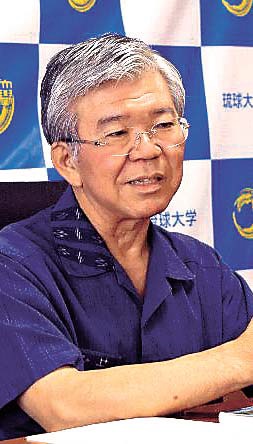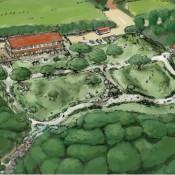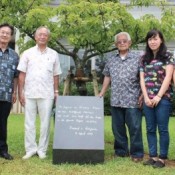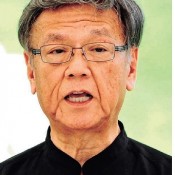Top News

June 25, 2015 Ryukyu Shimpo
On June 24 at a regular media meeting, President Hajime Oshiro of the University of Ryukyus criticized the central government’s requests to display the national flag and have participants sing the anthem at entrance and graduation ceremonies. On June 16, Hirofumi Shimomura, Minister of Education, Culture, Sports, Science and Technology, requested presidents of public universities display the national flag and have participants sing the national anthem at university ceremonies. Oshiro claimed; “As the state encourages universities to nurture global human resources, such a request for flag raising and anthem singing is inappropriately nationalistic.” If the discussion about the national flag and anthem is extended to the wider university staff, this could create division and confusion. Oshiro suggested shelving the issue.
Regarding the request from the Minister, Oshiro said, “I wonder what international students from Asia would think of this. Raising the flag and singing the anthem should not be forced.”
The University of the Ryukyus was established in 1950 under the order of the U.S. military administration. Later, it was transferred under the jurisdiction of the Government of the Ryukyu Islands, and the University became a national university upon Okinawa’s reversion to the Japanese administration. According to the university, the university has not officially raised the national flag or sung the anthem at entrance and graduation ceremonies since 1981.
About 260 to 300 international students study at the university every year. International students’ home countries are mostly in Asia, including China, which has the highest number of enrolments, Korea, Indonesia, and Taiwan.
President Oshiro stated his opinion saying; “If the university raises the national flag, I would like to raise all flags of all countries where international students are from. That would be more meaningful when we encourage global education.” Within the Diet, there are other opinions, including the claim that public universities should respond to the government’s request because they use tax. Oshiro noted, “Giving back to communities is the contribution that universities can offer. I do not think raising the flag is the way to give back for the tax input.”
(English translation by T&CT and Megumi Chibana)
Go to Japanese
June 25, 2015 Ryukyu Shimpo
On June 24, The Okinawa Regional Taxation Office released taxation figures on alcoholic beverages shipped by breweries in Okinawa Prefecture during fiscal 2014. Shipments of all alcoholic beverages declined 4.0% over the year to 71,258 kiloliters, generating 10.53 billion yen in tax, also down 4.0 percent, it said.
Shipments of and tax collected from Awamori declined for the 10th consecutive year, while those figures for beer saw a slight increase. Awamori’s decline was more notable in shipments to the Okinawan market than to the rest of Japan.
Beer shipments grew to 23,557 kiloliters, up 0.2 percent, generating 4.274 billion yen in tax, up 0.3%, in the third consecutive year of growth in both categories.
In contrast, Awamori shipments went down to 20,190 kiloliters, down 6.4 percent, generating 4.056 billion yen in tax, down 6.7 percent. Shipments of and tax collected from Awamori peaked in 2004. Of the total, shipments to the Okinawa market were down 6.8 percent to 15,782 kiloliters and those to other parts of Japan decreased by 5.1 percent to 4,409 kiloliters. Shipments to Okinawa declined for the ninth year and shipments to other parts of Japan declined two years in a row.
Shipments of other alcoholic drinks, such as happoshu, or low-malt beer, sake and liqueur went down 5.6 percent to 27,511 kiloliters to generate 2.2 billion yen in tax, down 6.6 percent. This was the first decline in two years.
Shipments of all alcoholic beverages, at 71,258 kiloliters, roughly equal nine and a half times the giant water tank at the Okinawa Churaumi Aquarium. Their shipments and tax peaked in 2004 and continue to decline, except for an increase seen in fiscal 2013.
Due partly to the decreasing population, alcohol consumption continues to shrink nationwide. In addition, as with other parts of Japan, tastes of local young people seem to be moving away from alcoholic drinks in general.
(English Translation by T&CT and Scott Murphy)
Go to Japanese

June 25, 2015 Ryukyu Shimpo
On June 24, at the ongoing regular June session of the Okinawa Prefectural Assembly, Governor Takeshi Onaga described the soul of Okinawa as “living with pride, honoring the hard work and struggles of our ancestors, and wishing that our children and grandchildren will be able to live in true happiness.” His comment was in response to a question by Shamin-Goken Net Party representative Taiga Teruya. He made his own reflection on the soul of Okinawa, while making reference to reflections made by previous governors.
Governor Onaga stated, “I believe [previous governors] have all spoken candidly about the soul of Uchina (Okinawa) from their own perspective, with deep consideration for the sentiment of the Okinawan people in the historical period in which they lived. I have been very much influenced [by previous governors], and I thought about my own perspective with their views in mind.”
When Governor Onaga went to Hawaii and Washington D.C. during his visit to the United States at the end of May, he received a warm welcome from people of Okinawan descent everywhere he went. He said that he strongly felt their passion for Okinawa and their love for their homeland, and explained that his perspective on the soul of Okinawa included the love that Okinawans all over the world, connected by the same common ancestors, feel for Okinawa.
Previous Okinawan governors have also garnered attention when expressing their own unique view of the soul of Okinawa. Their views were based on the relationship between Okinawa and mainland Japan and the social conditions of the time. Former Governor Junji Nishime’s 1985 depiction of the soul of Okinawa as “a desire to become Japanese while being unable to do so completely” has been remembered over the years and is still widely quoted.
Former Governor Masahide Ota described the soul of Okinawa as “a communal love of peace,” and former Governor Keiichi Inamine described it as “a magnanimity that merges many different things”. Former Governor Hirokazu Nakaima spoke of the soul of Okinawa as a combination of the previous three governors’ ideas.
At a regular press conference on May 15, when asked about the soul of Okinawa in relation to the fact that Okinawa would soon reach 43 years since its reversion to Japan, Governor Onaga said that Okinawans have always felt that even if they try to get closer to mainland Japan, they might always be kept at arm’s length.
(Translation by T&CT and Sandi Aritza)
Go to Japanese

June 25, 2015 Ryukyu Shimpo
Internationally acclaimed anime director Hayao Miyazaki is planning to build a community facility for children in Zenda Forest Park of Kumejima. Miyazaki will invest 300 million yen into construction of the facility as a donation to the town. Kumejima Town will provide about 10,000 square meters of land to be part of a park included in the facility. It will be designed in a way that utilizes rocks and trees in the natural environment to create a space where children can play freely in nature. The anime director aims at completing construction within two years.
Those involved with the project, including local designers, a representative of the town, and the project’s general director Tomihiro Horino, who is a friend of Miyazaki, held a community meeting on June 24 to explain to local residents about the plan.
The project is called, “The forest where the wind returns.” It aims to give children from Kumejima Island, and children visiting from elsewhere, a place where they can play and study together in the unspoiled island. The founders hope it will help them grow up strong and equipped to make the most of life.
The project organizers plan to construct a two-story building, which will be able to accommodate about 30 people. Visitors can stay in the building’s accommodation and use a library.
Its total floor area will be about 1,000 square meters.
At the end of last year, Horino, who came up with the plan, negotiated between Miyazaki and town government staff. Kumejima-based design company Kume Creation was in charge of planning and research for the construction. In the future, the town will set up a team to discuss and support a plan to improve the environment around the facility.
(English translation by T&CT)
Go to Japanese
June 26, 2015 Ryukyu Shimpo
Novelist Naoki Hyakuta’s claim that the two newspapers of Okinawa should be shut down is an example of suppression of free speech; media will only be allowed to report on what meets the intentions of the administration. These are absurd remarks that deny the freedom of the press and freedom of expression, which are the foundation of democracy.
Hyakuta has a freedom to speak out. However, on the occasion of the meeting held at the headquarters office of the Liberal-Democratic Party, the ruling party in the Diet, lawmakers mounted criticism against the local newspapers of Okinawa, prompting Hyakuta’s remarks. We cannot overlook his remarks, including the discussion that led to them.
In addition, he also remarked, “[U.S. Marine Corp Air Station Futenma] was originally located in a rice field. People began to live near the base, where it is convenient for doing business.” This is not correct because the former Ginowan village office was located near the current runway before the war, and had been a center for the community since the Ryukyu Kingdom era. We would like to ask him to admit his factual error.
Okinawa’s newspapers cooperated with the government’s policy to wage the war before and during the war. After the war, Okinawa’s newspapers started their own business, regretting that they had committed the fault of supporting the government’s war policy. Many media people do not want reporting to once again support the lead up to war.
It is a matter of course for media outlets to publish critical reports on the government because journalism has a watchdog role, which means monitoring the political power. A society that secures the right to critical reports of those in power is a sound one. It is simplistic and dangerous to think that media should be shut down because they are critical of the government. We think it is a dangerous threat not only to the two newspapers of Okinawa, but to the mass-media outlets in the country.
The Ryukyu Shimpo and the Okinawa Times will resolutely oppose attempts to attack the freedom of expression and freedom of speech.
Yoshikazu Shiohira the editor in chief of the Ryukyu Shimpo
Kazuhiko Taketomi the editor in chief of the Okinawa Times
(English translation by T&CT)
Go to Japanese
June 26, 2015 compiled from reports of Ryukyu Shimpo and Kyodo News
About 40 young Liberal-Democratic Party lawmakers close to Prime Minister Shinzo Abe held a study session to promote revising the Constitution on June 25 at the party headquarters.
A lawmaker who took part in the meeting reportedly advocated punishing news media that are critical on the security-related bills, “a way to punish mass-media is to cut their income from advertisement. I want intellectuals to ask the Federation of Economic Organizations (Keidanren) to help financially pressure media.”
Responding to a lawmaker who complained that the local newspapers in Okinawa are critical of the government, Hyakuta said, “The two newspapers of Okinawa should be shut down.” He claimed that they might change their stance if an island of Okinawa were taken over by China. Hyakuta said,” people have chosen to live near the airfields, where it is convenient for doing business. I want to ask them about this.”
Minoru Kihara, director of the party’s Youth Division, hosted the meeting, Katsunobu Kato, deputy chief cabinet secretary, and Koichi Hagiuda, special assistant to the LDP president, also attended the meeting. They are close to the prime minister.
Kihara relieved of his post as director of the LDP’s Youth Division
The Liberal-Democratic Party has relieved Minoru Kihara of the post for one year, due to remarks about the media that could be taken as threatening to suppress freedom of the press.
Secretary-general of the Liberal-Democratic Party Sadakazu Tanigaki announced a reprimand of Kihara, director of the party’s youth division, at a press conference held on June 27 at the party headquarters. He said, “We cannot overlook this issue, because he has lost the public’s confidence in our party.”
(English translation by T&CT)
Go to Japanese

June 16, 2015 Ryukyu Shimpo
On June 16, Social welfare corporation Network Sousei hosted a concert with Zimbabwean music group JENAGURU performing at Shuri Community Hall in Shuri, Naha. Zimbabwe is located in the Southern part of Africa, and the JENAGURU performs traditional music from that area.
About 150 people, including customers of the Sousei and children from Kindergarten Maaru, took part in cultural exchange through dance and music.
The JENAGURU consists of students from the JENAGURU Art Centre. They introduced drums and other instruments made of Ngoma tree and performed a traditional cerebration and rain dance. Participants clapped their hands in rhythm to the drums and the instruments, and enjoyed the concert. Daichi Nakahara remarked, “The drum rhythm was fun and I danced with the band.”
(English translation by T&CT, Hitomi Shinzato)
Go to Japanese

June 22, 2015 Ryukyu Shimpo
Meio University has set up a commemorative plaque honoring late Richard von Weizsäcker’s peace message beside a Hikanzakura cherry tree he previously planted at the campus in Nago.
Weizsäcker, the first President of Germany after unification, was invited to speak at an event to celebrate the fifth anniversary of the university’s establishment in April 1999. He gave a lecture on the theme of the future of Okinawa, and planted a Hikanzakura cherry tree. The university had set up a wooden plaque in commemoration of this event, but it had become old. The university renewed it with a stone plaque.
On June 22, ahead of the Okinawa Memorial Day, the unveiling ceremony for the plaque was held in the courtyard of the university.
Participants renewed their determination to foster peace, which is one of the fundamental goals of the university. Ninety-six-year-old Frank Higashi, American citizen and elder brother of the late emeritus president of the university Yasuharu Agarie, attended the ceremony. Higashi joined the Battle of Okinawa as an interpreter soldier and saved many Okinawa residents.
(English translation by T&CT)
Go to Japanese

June 23, 2015 Ryukyu Shimpo
June 23 has come for the 70th time.
One of the most ferocious land battles in history occurred in our homeland of Okinawa. More than 200,000 precious lives were sacrificed. We will never be able to forget the sadness of losing our loved ones; our family and our friends.
We cannot forget because in Okinawa, we have the memory of the horrors war brings clearly etched in our eyes and ears, and on our skin. We cannot forget because we wish from our hearts for the peace of those who were lost in war, and we fervently hope for eternal peace.
Our strength helped us walk a path of reconstruction and development after the war without ever forgetting those wishes and hopes.
However, 73.8 percent of U.S. military exclusive use facilities in Japan, which uphold the U.S.-Japan security system, are located in Okinawa, which makes up only 0.6 percent of Japan’s land mass. This excessive burden of bases continues to impact the lives of Okinawans and Okinawa’s economic development in a multitude of ways. Even if the U.S. military bases south of Kadena Air Station are consolidated as part of the U.S. military realignment, beginning with the relocation of MCAS Futenma to Henoko, the proportion of U.S. military exclusive use facilities in Japan that are located in Okinawa will only be reduced by 0.7 percent The timeline for return of this land is also unclear. Therefore this plan far from amounts to a reduction of the base burden.
Okinawa’s U.S. military base issue is an issue of Japan’s national security, and it is a crucial issue that should be shouldered by Japanese citizens as a whole.
In particular, regarding the relocation of MCAS Futenma to Henoko, the will of the Okinawan people was made clear in last year’s elections. It will be extremely difficult to build a new military base in Henoko.
MCAS Futenma was built on land seized from Okinawans forcibly without our consent, and it has been called the most dangerous air base in the world. It would be unacceptable to keep it in operation permanently. Furthermore, the idea that it must be relocated to Henoko in order to eliminate the danger it poses, or that Okinawans must propose an alternative solution if we don’t like the current plan, is not something that the Okinawan people can accept.
It is impossible to build a cornerstone of peace if freedom, equality, human rights, and democracy are not guaranteed equally for all citizens.
I strongly hope that the Japanese government will decide to cancel all work pertaining to the relocation of MCAS Futenma to Henoko, and that it will rethink its policy to reduce the burden of bases on Okinawa without being held down by preconceived notions.
In the world today, many people are losing their lives and having their dignity trampled on, as a result of regional conflict, terrorism, discrimination and poverty. Such tragedies occur every day.
In order to face this reality and solve the problems that threaten peace, it is crucial that each and every one of us has a strong determination to proactively pursue peace.
In Okinawa, our forefathers acted as a bridge between the nations of Asia. As we approach 70 years since the end of World War II, we will inherit their embrace of all nations of the world and work to achieve development and peace in the Asia-Pacific region.
For the sake of our children and grandchildren who will inherit the future, we will create wealth we can take pride in, and strive for a rich Okinawa where there will be smiles on our children’s faces for all time.
On this Day of Memory, I mourn for the souls of those lost in the war from the bottom of my heart, and I declare my determination to work tirelessly to build a bright future for Okinawa as a place to promote everlasting peace.
June 23, 2015
Okinawa Governor Takeshi Onaga
(English translation by T&CT and Sandi Aritza)
Go to Japanese

June 24, 2015 Ryukyu Shimpo
On June 23, the Okinawa Prefectural Government and the Assembly held the Okinawa Memorial Day ceremony on the 70th anniversary of the end of the Battle of Okinawa at the Peace Memorial Park at Mabuni in Itoman. During the Battle of Okinawa, more than 200,000 people were killed.
Many people, including members of the bereaved families who suffer from sadness even after 70 years have passed, visited the Cornerstone of Peace at the park. The services were held at memorial towers around the prefecture, and prayers and requiem masses were offered. The participants pledged no more war.
At the memorial ceremony held at Mabuni, Governor Onaga pointed out the absurdity that 73.8 percent of U.S. exclusive-use facilities in Japan still are concentrated on Okinawa. He stated, “All people in Japan should bear the load of the U.S. military base issue equally.”
According to the organizers, about 5,400 people took part in the memorial service.
The attendees offered silent prayers for one minute at noon.
Governor Onaga announced the Peace Declaration for his first time after taking office last December. He vowed to work for lasting peace by learning the lessons from the Battle of Okinawa.
The governor urged the government to cancel construction work in Henoko, Nago, where the government plans to move U.S. Marine Corps Air Station Futenma. He asked the government to reduce the base burden on Okinawa.
Prime Minister Shinzo Abe, the related ministers, Speaker of the House of Representatives Tadamori Oshima, Upper House President Masaaki Yamazaki and U.S. Ambassador to Japan Caroline Kennedy attended the ceremony.
Prime Minister Abe stated, “Having gone through a history of hardship beyond description, those of us living today enjoy peace, safety, freedom and prosperity. We want to appreciate the value of it again.”
However, Prime Minister Abe did not refer to the construction of the new U.S. base in Henoko. He was jeered by some angry citizens.
Masaharu Kina, the chairman of the prefectural assembly, complained about issues arising from the U.S. military base in his speech. He stated, “There is a discriminatory and excessive burden on Okinawa. We are still in the midst of the process of the post-war settlement.”
Naeko Teruya, the chairwoman of the Bereaved Families of Okinawa Prefecture War Dead Joint Association, said, “We will stand resolute against base construction which leads to war.”
Twenty years have passed since the Cornerstone of Peace was built. The names of 241,336 war dead have been engraved on it.
(English translation by T&CT)
Go to Japanese
June 19, 2015 Ryukyu Shimpo
Naha will become the second administrative region in Japan to declare support for sexual minorities, also known as LGBT, following Yodogawa District in Osaka. Naha city will make a “City LGBT Support Declaration” on July 19. With the declaration, Naha city aims to publicly promote itself as a prefectural capital that actively supports diversity and awareness about LGBT issues.
The declaration will be made at the Pink Dot Okinawa event at the Tenbusu Square in Makishi, Naha. Naha City has been co-hosting the event since 2013, while actively engaging in promoting awareness of the LGBT population such as hosting workshops targeting Naha citizens since 2000.
The declaration will also be made in writing. It aims to take tangible steps towards improving awareness around LGBT issues, such as holding workshops for city officers as well as opening a counseling corner. The steps further aim to build a structure in which LGBT people and their families feel comfortable in sharing their experiences with the government, and in having a community that is more aware of them. A representative of the Naha City Government emphasized the importance of the declaration; “We hope this declaration will lead to build a society where individual citizens can understand one another.”
(English translation by T&CT and Sayaka Sakuma)
Go to Japanese







 Webcam(Kokusai Street)
Webcam(Kokusai Street)


